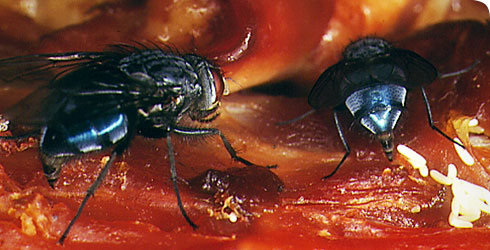Biology
Size
- Calliphora vicina flies are generally large, 5-13mm in length.
- Their considerable size range is an adaptation to relying on carrion as a larval food source. The level of competition can be extremely high, and the food source only lasts a short time.
- Within limits, maggots receiving only limited nutrition before the food runs out are able to mature into miniature adults.
Growth
The growth rate of C. vicina has been studied in great depth because of the forensic importance of this species throughout temperate Europe.
As poikilotherms, temperature has the biggest effect on their rate of growth. Records in the literature give the time needed to develop from egg to adult emergence as 18-24 days at 27oC, compared with 31-35 days at 15oC.
Temperature also affects final adult size, with smaller adults emerging from cultures reared at high temperatures. Temperatures above 30oC appear to be lethal to C. vicina.
The quality and quantity of the available food also affect growth.
Final adult size has a profound effect on the fly's:
- longevity
- fecundity
Life expectancy
Little is known of the life span of British blowflies in the wild. It is thought that the majority of C. vicina females only survive to lay one batch of eggs, which would give them a life span of 1 to 2 months.
- In the south of the UK a small population of flies will over-winter as adults, surviving for 6 months or more.
- In the north, the population over-winters as post-feeding larvae in a state of arrested development known as diapause. The trigger for this is declining day length and low temperatures, and it is broken in the spring when temperatures increase.
-

Reproduction, lifecycle and dispersal
In Britain, the breeding season of carrion blowflies is restricted only by temperature. Discover more about their reproduction, as well as their lifecycle and potential dispersal mechanisms.
Toolbox
Glossary
Fecundity
Number of offspring an individual can produce.
Poikilotherms
Cold-blooded organisms.
